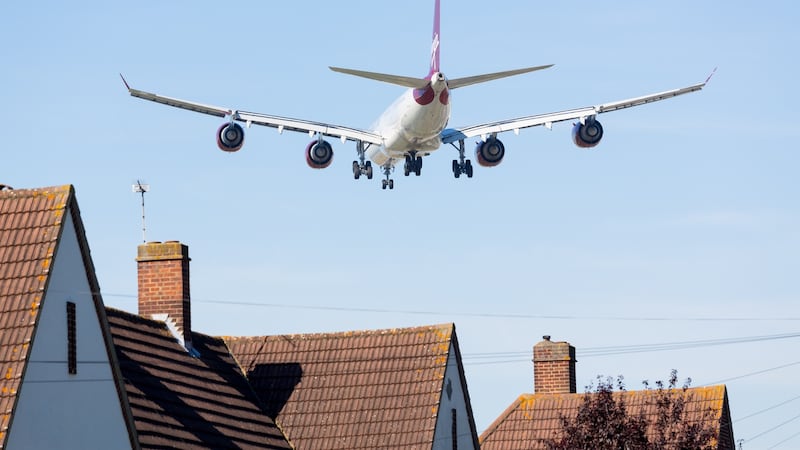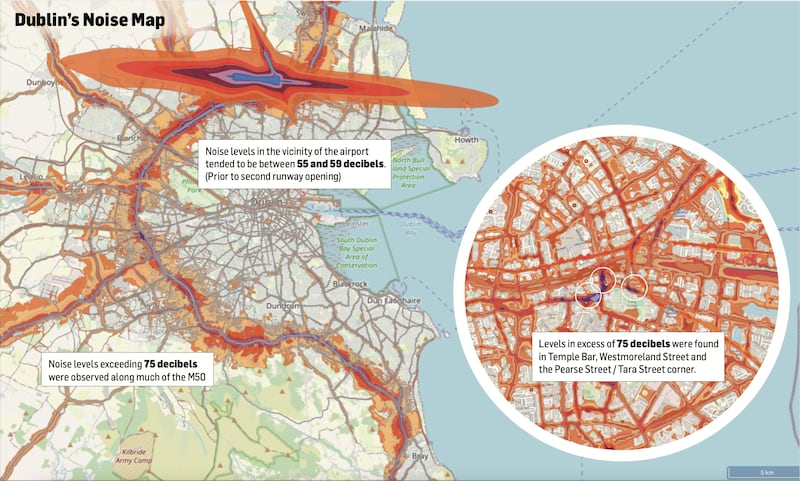The noise created in Dublin and its surroundings captures the reality of modern life – the thumping arc of decibels emanating from the M50 and the motorways branching off it, and the lattice of noise on city streets.
The evidence for the damage noise can do to people’s physical and mental health is mounting. Yet there is a glaring lack of research on the effects noise pollution from cars, aircraft, railways and even just living in urban areas can have on quality of life.
Predictably, the most annoying sounds are typically associated with transport – aviation, road traffic, railways – and living in urban areas, but there are knowledge gaps elsewhere, too – entertainment, neighbours and new sources such as noisy heat pumps or mechanical ventilation in heavily insulated houses.
The lack of information has prompted the House of Lords Science and Technology Committee to begin an inquiry into noise effects on human health, which held its first hearing last month. There is every indication the same issues apply to Ireland.
READ MORE
“The levels we are talking about when we look at noise and health are much lower than occupational noise levels and lower than levels that give effects on hearing,” says Anna Hansell, professor of environmental epidemiology at the University of Leicester.
The issue will soon be further complicated by changes to “the soundscape” predicted to bring new forms of unwanted noise, says Dr Antonio Martínez, acoustical engineering specialist at the University of Salford.
Aerospace is about to change profoundly due to drone usage and new forms of urban air mobility.

One study took measurements of blood pressure every 15 minutes overnight in 140 people living near airports, and found if an aircraft went overhead, blood pressure and heart rate would go up in response to that but the person would not necessarily wake up
The most radical change, however, will be a switch to electric mobility, he says. “We will experience going from the engine noise of traffic in cities to basically no noise or just some high-pitched sound produced by electric cars. That will be quite a significant difference that probably alters all the evidence for road-traffic noise.”
That means moving from low-frequency broadband noise – from internal combustion engines – towards more high-pitched sounds from EVs, even where speed limits are very low, and may result in “more annoyance scenarios”.
There is much evidence of the effect noise can have on sleep disturbance, but there are links, too, on cardiovascular health and a possible link to respiratory disease. “The strongest evidence is on ischaemic heart disease, so heart attacks, in relation to road traffic noise. There is some evidence on metabolic impacts – for example, diabetes,” says Hansell.
One study took measurements of blood pressure every 15 minutes overnight in 140 people living near airports, and found if an aircraft went overhead, blood pressure and heart rate would go up in response to that but the person would not necessarily wake up. The body can become sensitised to unwanted noise; even if people do not react to it on a conscious level, it will still have a physiological response.
There is firm evidence on aviation noise impairing children’s learning, and indications it affects long-term and short-term memory, but a lack of research on mental health, wellbeing and quality of life effects. “This is increasingly a concern of communities, but we have not studied this well at all ... and that’s an area that we should focus on,” says Charlotte Clark, professor of epidemiology at the University of London.
[ Dublin ‘noise maps’: How noise-polluted is your neighbourhood?Opens in new window ]
[ Residents around Dublin Airport asked to help prepare for legal action over noiseOpens in new window ]
What complicates matters is “sound accounts for only a small proportion of the annoyance we measure”, she says. “There is a whole range of factors – individual factors such as your age, your biological sex ... if it is airport noise, your attitude to the airport, how irritated you are, what it is disturbing, if you cannot hear the television or the radio.”
People in their 20s are far more tolerant. “Annoyance tends to peak in your 40s as you come into middle age, and as you get older and perhaps happier and more relaxed with the world, you are less concerned with noise,” she says.
With neighbour noise, the issue can be a matter of perception. “If you listen to music at home and you value that music positively, yet your neighbours are basically annoyed because they are trying to read, it is noise for them,” says Martínez.

An interactive version of the EPA’s noise map can be viewed here
Clark adds: “A lot of this is about control ... You might even like your neighbour playing Taylor Swift loudly all the time, but just not at that particular moment. That is where building regulations can become quite important, because you can often find yourself having no control over exposure to some environmental sources or neighbour noise.”
In Ireland the knowledge gap is equally obvious and there is an absence of a framework for action. World Health Organisation guidelines from 2018 have not yet been implemented, though noise regulations introduced in 2021 do set a pathway for how this will be achieved.
The EPA, which reports on noise to the EU, is preparing for a fourth round of noise maps required under the EU environmental noise directive, which will inform action plans. Responsibility for “strategic noise maps” lies with designated bodies, including Transport Infrastructure Ireland; local authorities, Irish Rail and airport operator DAA.
There were 2,274 noise complaints received across 31 local authorities in 2021, accounting for 3 per cent of complaints. There were some 1,900 noise complaints in 2020. In 2022, however, there were 729 complaints made by the public in relation EPA-licensed facilities including large manufacturing plants. More than half the complaints related to noise (54 per cent); the 2021 breakdown was 45 per cent.
Dublin Airport is probably the single most significant flashpoint, especially since the opening of its north runway last year. Excluding reports from a serial complainant, the number received from other members of the public still more than doubled from 1,296 in 2021 to 2,765 last year.
[ How to deal with noisy neighbours (Hint: don't turn the hose on them)Opens in new window ]
All told, Ireland faces the same issues raised in the House of Lords, says noise and vibration consultant Diarmuid Keaney. With the United Kingdom leaving the EU, however, they are not obliged to enhance their noise mapping.
By contrast, Ireland must map transportation noise every five years or so. In the past it was limited to national and regional roads, but now local roads that carry more than three million vehicles per year must be included in the list.
“As Ireland grows in population and as we move towards higher-density living, noise intrusion and annoyance from noise are likely to increase,” he says. In anticipation of this, the government in 2014-2015 introduced compulsory sound insulation testing as part of constructing new buildings and extensions and material alterations to buildings.
[ The noisy heat pump in our new home is keeping us awake at night. What can we do?Opens in new window ]
This standard only provides what is described as “reasonable resistance to the passage of sound”, but ensures buildings are of sufficient quality to provide some reasonable protection to occupants, he adds. “Buildings that multiple occupants share will always be challenging, and for those who want a high level of sound insulation or those who are highly sensitive to noise, then terrace, semidetached and apartment living are most likely not suited to some.”
There is an incorrect belief the required expertise is still unavailable here, he says. “We have our resources and expertise [notably in the Association of Acoustic Consultants of Ireland] to help navigate environmental noise, developing noise policy and noise guidance documents.”
But, unlike the UK, Ireland has no formal national policy on noise, says Keaney. “The Republic is crying out for a national noise policy statement. From that, we must develop guidance documents for road, rail, aircraft, entertainment, renewable energy and industry.”
His big concern, however, is acceptance of noise reports from those not qualified in environmental noise assessment. “So many noise reports are presented in the courts, on record with the planning authorities and noise reports lodged with agencies, and are all too often completed by individuals willing to ‘give noise a go’. Using qualified noise consultants would significantly ensure more effective noise monitoring.”
Human sensitivity to noise is highly variable, and the human response to noise is highly varied ... The response to noise can be subjective and is affected by many factors, both acoustic and non-acoustic
All noise modelling and maps have uncertainty and assumptions, says Keaney. “Local authorities are coming under increased pressure to implement noise action plans to help reduce noise exposure. However, before this happens, we need to question the accuracy of our noise maps and their intended purpose ... noise mapping is valuable, but accuracy and validation would be strongly advised, particularly before embarking on costly noise mitigation measures.”
Reducing noise at the source is best, rather than just muffling it, he says. “So while there are proven health impacts associated with long-term noise exposure, we must be careful how we determine that. While noise maps are a practical broad-brush approach to deciding where noise levels are likely to be highest, more work must be done to link noise maps to one’s exposure to environmental noise.”
Typically, noise contour maps are plotted and noise exposure is determined in residential garden areas and at residential dwellings but, Keaney says, few people sit in their garden 16 hours a day and spend eight hours in bed at night. Maps use metrics that assume a person it at a property 24 hours a day.
While more people may be working from home, some of the working population may spend evenings and nights at their homes but could be in their workplace for much of the day, he suggests. “So if we are looking at noise metrics associated with adverse health effects, we must be mindful that the maps look at the noise climate at a residential property rather than an individual’s noise exposure.”
[ DAA issued with fresh warning letters by council over runway noiseOpens in new window ]
People living near Dublin Airport’s new runway contend a change in flight paths by the DAA since February 23rd has led to more communities being significantly affected by aircraft noise.
The issue is contentious, Keaney acknowledges. While he does not wish to comment on specifics, he says noise complaints are complex. “Human sensitivity to noise is highly variable, and the human response to noise is highly varied ... The response to noise can be subjective and is affected by many factors, both acoustic and non-acoustic.”
The House of Lords committee heard it was possible to manage aircraft noise with better planning of flight tracks. “We have the technology these days to send the aircraft very accurately to the areas we want to,” says Martínez. In addition, descents are steeper and quieter planes are increasingly used.
With noise complaints from the public increasing, current control measures “do not always allow for them to be adequately addressed”, the EPA warned in 2020. Local authorities, it advised, “need to take a much stronger leadership role in dealing with noise issues”, and in designating quiet areas in cities for health and wellbeing value.
Dublin City Council has identified eight “quiet areas” and uses its noise action plan as a tool to preserve tranquil areas with existing low levels of environmental noise. It focuses particularly on public parks, aiming to provide quiet and peaceful spaces for people to escape to from the wider urban area with its higher levels of environmental noise.
It has set noise thresholds to help in designating quiet areas. The designation is considered in the context of any proposed future development in the vicinity of these quiet locations to determine whether it might have the potential to negatively affect existing noise levels.
Meanwhile, numerous studies highlight benefits of planting more trees in urban areas in reducing air and noise pollution especially – two areas where up to recently human health impacts have been underestimated.
The approach now is evaluating whole soundscapes, says Martínez. “We are trying to stop focusing on negative sounds – noise – and trying to design cities in a way that maximises the sounds that have a value for us. That is why we are trying to bring nature sounds, water sounds, any representative sound or historic sound into cities.”





















